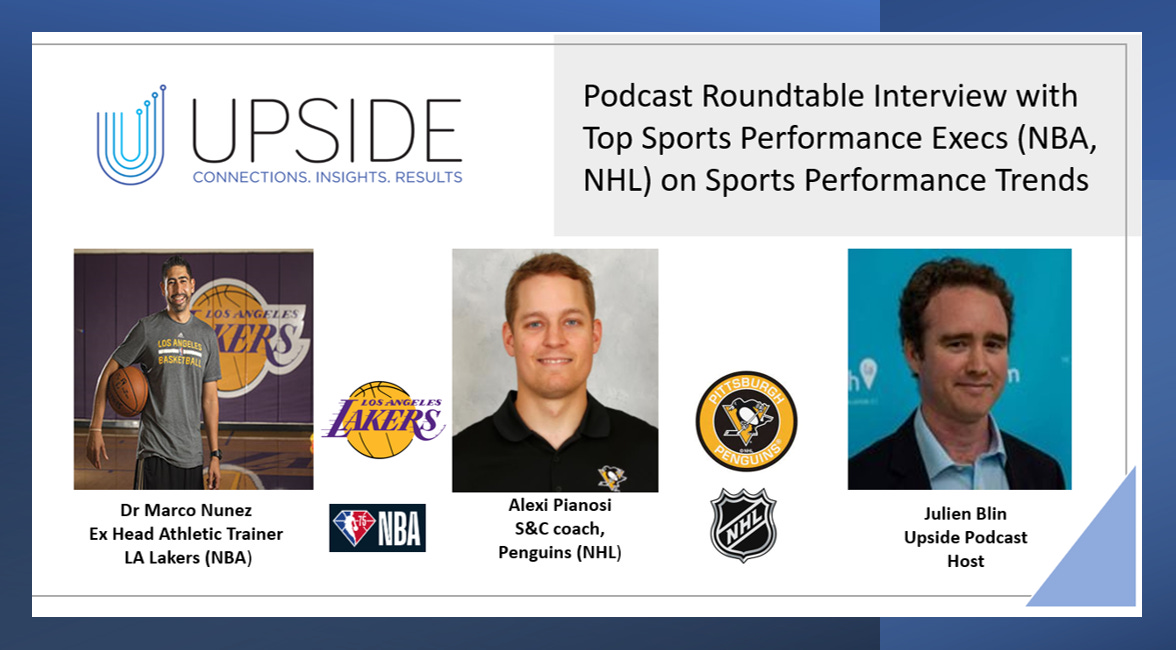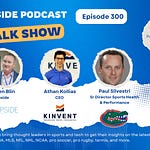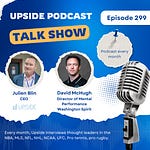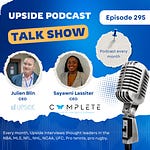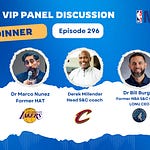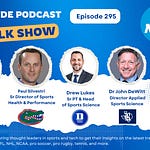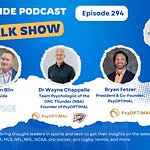This week we have the honor to interview a group of NHL sports performance executives to talk about the latest trends in the world of sports performance, load management, sleep/recovery management, rehabilitation and data & wearable tech integration, and mental performance in the NHL.
Alexi Pianosi, Head S&C coach, Colorado avalanche (NHL Team).
Adam Douglas, S&C coach, Pittsburgh Penguins (NHL Team).
Chris Stackpole, VP Athlete Care, NJ Devils (NHL Team).
📝Show Notes: Through this interview, we touched on the best practices related to:
Load Management & Injury Prevention.
Performance Training Innovations.
Rehabilitation & Return to Play.
Sleep & Recovery Management.
Data & Wearable Tech in Decision-Making.
Psychological & Mental Performance.
You can read the full transcript of the podcast interview located at the top of this blog post.
Here are some of the best quotes of our conversation with Alexi, Chris and Adam:
1. On Load Management & Injury Prevention
Adam Douglas: “In hockey, load management is almost like a dirty word. The culture has always been about grinding, pushing through, playing through pain. So when we bring up the idea of managing workload strategically, there’s sometimes resistance—not just from players, but even from coaches and front office staff. But I always stress that load management doesn’t mean doing less. It means doing what’s appropriate at the right times. If we’re smart about monitoring player workloads—whether it’s game intensity, travel fatigue, or practice demands—we can find the right moments to push them harder and the right times to pull back. It’s about keeping guys at their peak for as long as possible and making sure they don’t burn out before the playoffs.”
Chris Stackpole: “The biggest challenge we face is managing the fine line between keeping players on the ice and protecting them from overuse injuries. Hockey players have this deep, ingrained warrior mentality—they don’t want to miss a single practice, let alone a game. So our approach has to be strategic. We use a collaborative model where our medical, performance, and coaching staffs work together daily. If we see red flags—whether it’s based on physical output data, subjective feedback, or just gut instinct from years of experience—we communicate that with the coaches in a way that aligns with team goals. It’s about creating a shared language where everyone, from the head coach to the athletic trainer to the players themselves, understands the bigger picture.”
Alexi Pianosi: “The unpredictable nature of our schedule makes it incredibly difficult to plan load management perfectly. You can set a structured workload plan, but then a rivalry game turns into a highly physical battle, intensity spikes, and neuromuscular fatigue is suddenly way beyond what you anticipated. It’s not just about volume—it’s about the type of stress players endure. That’s where technology comes into play. We can track workload and stress accumulation over time, but more importantly, we need to interpret that data in a way that makes sense for real-world decision-making. The key is adaptation—having a plan, but being flexible enough to adjust based on the unique demands of each week.”
2. On Performance Training Innovations
Alexi Pianosi: “I think the biggest shift we’ve seen in strength and conditioning over the past five years isn’t just about technology—it’s about how we understand movement. Every player has a unique way of generating power, absorbing impact, and handling the demands of skating. If we don’t train with those specific patterns in mind, we’re either limiting their potential or increasing their injury risk. Now, we use force plates, motion tracking, and individual biomechanical assessments to design training programs that aren’t just about getting stronger in a generic way, but about developing strength and resilience in the exact ways they need for hockey. It’s a more precise, individualized approach that has a massive impact on performance.”
Adam Douglas: “The 1080 Quantum has been a game changer for us. The isokinetic resistance allows players to produce high force outputs without experiencing the same muscle soreness they would from traditional heavy lifting. That’s huge during the season when we need to maintain power without interfering with recovery. We use it for targeted strength work, focusing on explosive movements that directly translate to on-ice performance. Our guys love it because they feel stronger and more explosive without feeling drained the next day, and we see the benefits in their skating speed, acceleration, and durability over the course of the season.”
Chris Stackpole: “One of the biggest innovations for us has been integrating tools like blood flow restriction (BFR) training and neuromuscular stimulation devices like the Neubie. Some players simply can’t handle heavy loading due to past injuries or wear-and-tear, but we still need to keep them strong. BFR allows us to create a high-intensity training effect with lighter loads, reducing joint stress while still improving muscle activation. Neuromuscular stimulation helps activate muscles more effectively, speeding up recovery and improving movement efficiency. As these tools become more refined, we’re seeing them become a staple in high-performance training across the league.”
3. On Rehabilitation & Return to Play
Chris Stackpole: “The way we approach rehab has changed dramatically. Instead of players feeling like they’re ‘doing rehab’ and then ‘getting back to training,’ we’ve blurred the lines so that rehab seamlessly transitions into full training. That way, by the time a player is cleared, they’ve already been working at game intensity in a controlled way. We structure everything so that the workload progression is aggressive enough to fully prepare them for the demands of competition while minimizing reinjury risk. It’s about making sure they don’t just ‘feel good’—they need to be physically and mentally ready to compete at the highest level.”
Adam Douglas: “Hockey used to be very subjective when it came to return-to-play decisions. It was a lot of, ‘How do you feel?’ and then a coach or therapist making a call based on gut instinct. Now, we’re using objective data to drive those decisions. We establish baseline data for players, track their recovery progress, and use that information to determine when they’re truly ready to return. There’s no guesswork—it’s all about measured progressions. If a guy needs more time, we know exactly why. If he’s ready to go, we have the numbers to support it.”
Alexi Pianosi: “Rehab is really just progressive loading—gradually increasing the amount of stress on the injured tissue while also reintegrating cognitive and game-like demands. You can’t just heal a muscle or joint and throw a player back into full-speed hockey without preparing them for the real demands of the game. The key is making sure we are not only restoring physical strength but also reintroducing the complexity of the sport—reactive movements, decision-making, and unpredictable situations—so they aren’t just physically ready but also mentally prepared to perform at a high level.”
4. On Sleep & Recovery Management
Alexi Pianosi: “People don’t realize how difficult sleep management is in hockey. Players’ adrenaline is so high after a game that some of them don’t even start winding down until 2 or 3 AM. Then you throw in travel, late hotel check-ins, time zone changes—it’s brutal. We do what we can to optimize sleep hygiene, from delaying morning meetings to educating players on recovery strategies, but it’s an uphill battle. Sleep is the number one recovery tool, and yet it’s the hardest thing for players to control.”
Adam Douglas: “The one thing I would add was there’s a very strong collective bargaining agreement within the National Hockey League, and we actually are not allowed to monitor athletes' activities away from the rink. I had a conversation with an athlete yesterday that was like, well, why don’t you guys just buy 30 WHOOP bands and pass those out? And we had to explain to him who’s part of his union that that’s not allowed. Athletes can opt to share their information with teams, but it is very hard to do anything like that. So most of the teams, us included, have to look at it like Alexi said, try to work with each individual athlete to figure out what they need and help and support them that way, because we’re not allowed to monitor the athletes away from the rink.”
Chris Stackpole: “We get a lot of guys who have anxiety, some mental health-related issues. Trying to effectively manage those to help them kind of take the edge off—and they use so many stimulants with caffeine and whatnot during these games—that it’s near impossible for them to get to bed at a normal time. I’ve had a lot of struggles with trying to get guys to improve their sleep. So it’s been a lot of just educating on the potential harms of prescription sleep meds and trying to manage the mental health and relaxation perspectives, like Alexi mentioned. But yeah, it’s very challenging for what we’re restricted to do to make any meaningful dent in that.”
5. On Data & Wearable Tech in Decision-Making
Adam Douglas: “When I first started at Catapult in 2018, only six NHL teams were using on-ice wearables. Now, that number is over 26, and it’s growing every year. The technology has completely changed how we approach workload management and performance tracking. It’s no longer just about tracking how much a player skates—it’s about understanding the intensity, fatigue patterns, and how to adjust training accordingly. The more we integrate this data into our decision-making, the more we can optimize player performance and longevity.”
Chris Stackpole: "I think that's some of the challenge right now with the quality of the data that we're getting and the team's trying to integrate the information that they're getting from what we track, maybe in practice, and obviously restricted from doing anything in games. There just seems to be a disconnect right now with what we're trying to do and then obviously pushback from the players' union for what we're allowed to do and then obviously the data quality from what the league is generating."
6. On The Psychological & Mental Performance
Chris Stackpole: “The biggest challenge with mental performance in hockey is trust. A lot of players prefer to work with their own sports psychologists because they worry that sharing too much with the team could be used against them. We try to create a safe space, but it’s tough. Teams need to do a better job of embedding mental performance staff full-time, not just bringing someone in on a consulting basis. Until that happens, it’ll always be something players seek out individually rather than something that’s fully integrated into team culture.”
Adam Douglas: "There’s a real valuable opportunity to have an embedded mental performance consultant or sports psychologist, but that’s still growing in hockey. As performance departments have grown in the NHL, it’s important to support mental performance practitioners and integrate them into the broader performance strategy."
Alexi Pianosi: "You definitely can’t ignore the mental aspect—it’s a huge part of performance. But it’s complicated to get off the ground, especially when there are other priorities like data analytics and sports science. Is the biggest bang for your buck in terms of time investment going to be mental performance? If so, you embrace it. But right now, there’s still a lot more we can do with objective data before diving fully into that space. The challenge is that while teams are aware of mental performance, actually implementing it and getting players to buy in remains difficult—especially when many players prefer to work with their own private specialists."
You may also like:
🔥Upside Chat with Pierre Barrieu (Canada Soccer), Adam Quigley (MLS/NFL), Alexi Pianosi (Colorado Avalanche/NHL) on Concussions, ChatGPT, the Offseason, Mbappe, and More.
This week we had the honor to interview again a group of sports performance experts.
🔥Upside Chat with Alexi Pianosi (Penguins/NHL) and Dr Marco Nunez (Ex LA Lakers/NBA) on AI Tools to Prevent Injuries, Shockwave Therapy, and More.
This week we had the honor to interview again a group of sports performance experts.




